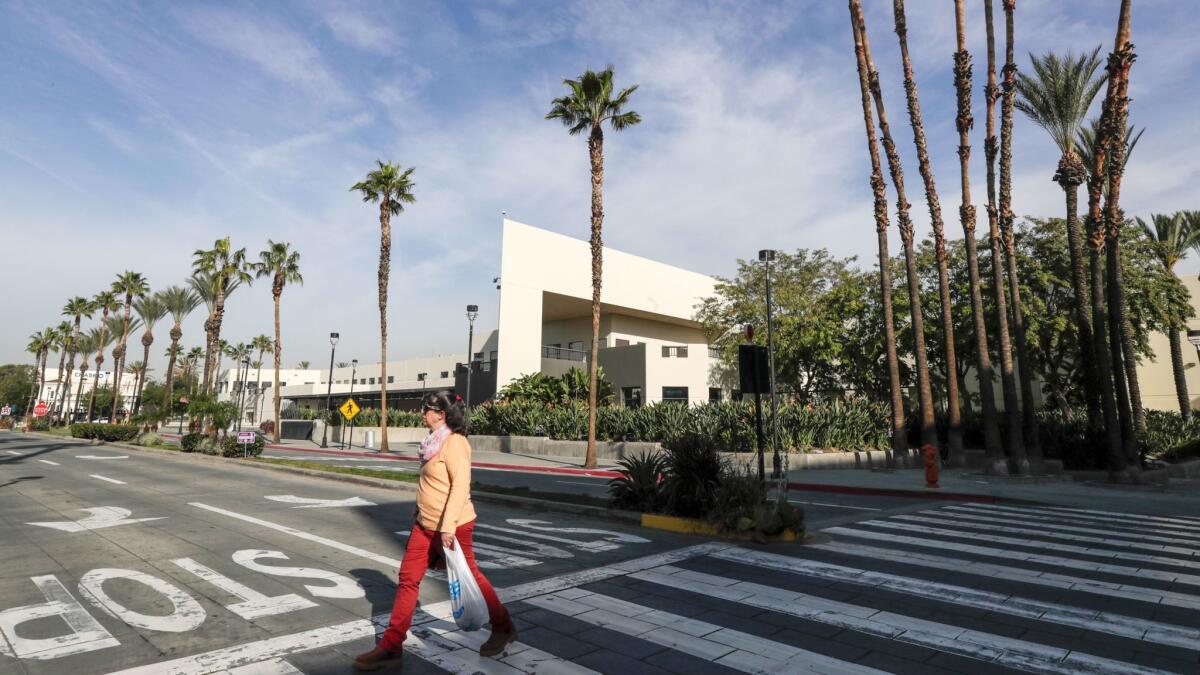Apartments replacing an old Ikea in Burbank? Some see it as an answer to the housing crunch
The city of Burbank has been going through a growth spurt, adding more than 16,500 jobs from 2010 to 2016 as employers such as Warner Bros. Entertainment boosted payrolls.
But, like much of Southern California, the city’s housing supply hasn’t kept up. Burbank built only 294 homes during that period, according to a city report, putting upward pressure on rents and prices.
Now a developer is proposing one of the most ambitious projects in decades: a 1,173-unit residential and retail project that would replace an old Ikea store at the Burbank Town Center mall, in part with apartments, some as small as 400 square feet.
Gaining the necessary approvals and community support could prove difficult given the downtown project’s size. But planning experts say such dense development — and different use of land — is needed if California is going to make a dent in its affordability crisis.
“Throughout California, cities and counties need to look at this more than they did before,” said Hasan Ikhrata, executive director of the Southern California Assn. of Governments, a regional planning authority. “They need to stop this not-in-my-backyard mentality.”
The mostly seven-story development at the corner of San Fernando Boulevard and Grinnell Drive is being proposed by CC Development Partners, a joint venture between Crown Realty and Development of Costa Mesa and Arrow Retail of Dallas.
The Ikea building would be demolished, as would an adjacent Office Depot and a handful of restaurants, including a Corner Bakery Cafe.

The $400-million, 16.5-acre project is still in the planning stages, and Crown and Arrow have proposed several versions that would include 881 to 1,173 homes, in addition to a hotel and retail and possibly office space.
“It’s exciting,” said Timothy Genske, a senior vice president at CBRE Group Inc. who has worked in downtown Burbank since 1989. “You have room to do something bold.”
Not everyone is so eager to see the project go forward.
Jim Casey of community group Preserve Burbank said he worries the development — across the street from Burbank High School — would further snarl traffic in the area, which he already avoids “like the plague between 1:30 p.m. and 3:30 p.m.”
Casey said he knows Burbank must build more to help with housing affordability, but the city can’t go overboard and must work to retain the “original character” that prompted people to move to Burbank in the first place. Too much density “will start to undermine what people like about Burbank, which is the ability to move around in it and live in a lower density environment,” he said. “What people are most concerned about is seeing high-rise after high-rise.”
The proposal is the second phase in the redevelopment of Burbank Town Center, where Arrow is finishing a $60-million renovation of the indoor mall. The developers say the new housing and hotel would help support the mall by adding a built-in customer base. They recently started the environmental review process.
Jim O’Neil, Crown’s executive vice president, hopes to go before the city for possible approval in a year. Construction could start a year later and wrap up in five to seven years, depending on market conditions.
O’Neil acknowledged there’s likely to be some resistance in the city, but said his company is listening to community feedback and has already increased the amount of open space proposed. The company, he said, also agreed to make 10% of the homes micro units to address concerns that too many new units would be unaffordable for people with lower incomes.
One potential option is a 70-unit, 15-story condo tower. City rules would require 15% of those units be reserved for households with low or moderate incomes, and the city said it would work to negotiate some affordability restrictions on apartments as well.
Beyond housing, there would be outdoor dining and a town square where people could shop at a farmer’s market, ice skate during the winter or watch movies on summer nights.
“This is going to be a gathering place for the community to come,” O’Neil said.
Mayor Will Rogers said he is taking a “wait and see” approach on the development until the environmental review is complete and final plans are put forth. But he does have concerns over the number of homes.
“Generally I think it’s in the right area for an intensive development, but how intensive remains to be seen. It could be 500. It could be 1,000. It could be 750. I don’t know,” he said.
“The number [1,100 homes] is daunting and obviously it’s what’s causing a lot of concern in the community,” he said. “Our constituency would like to see the city stay as much like it is today as possible.”
Tom Flavin, chief executive of the Burbank Chamber of Commerce, said more units are needed because the housing shortage has forced local businesses to go “further and further to recruit talent.”
A mayor of the city in the early 1990s, Flavin could not think of a bigger project in Burbank in recent decades. The city’s planning department said it hasn’t approved a larger project in at least 10 years.
Many economists say a lack of construction, relative to job and population growth, is the root cause of California’s sky-high housing costs. The shortage, they say, is created by a variety of factors, including community opposition, local regulations and a lack of developable land in urban centers.
Some state lawmakers are trying to boost supply by taking away some power from local officials.
For example, a bill introduced this year by Sen. Scott Wiener (D-San Francisco) would — subject to some limitations — eliminate restrictions on the number of houses allowed to be built within a half-mile of major bus routes and train, light-rail and other transit stations.
Like many cities, Burbank — home to two Metrolink stops — has had difficulty producing housing. In the last completed planning period for development, 2006 to 2014, the city permitted only 25% of what the state deemed necessary to keep up with demand.
Since 2012, the median home price in the city has soared 54% to $766,300, according to Zillow. Median rent jumped 32% to $2,645. Los Angeles County, over the same time frame, saw rents climb 33% to $2,460 and home prices 55% to $588,000.
Fred Ramirez, Burbank’s assistant community development director, said the city is taking some steps to streamline development, including updating its planning rules for certain areas.
O’Neil said he’s committed to working with residents to alleviate any concerns. But he maintains the proposal is better than if another retailer occupied the Ikea site.
“What is better for the community? What is better for the city?” he asked. “We need housing.”
Times staff writer Liam Dillon contributed to this report.
Follow me @khouriandrew on Twitter







